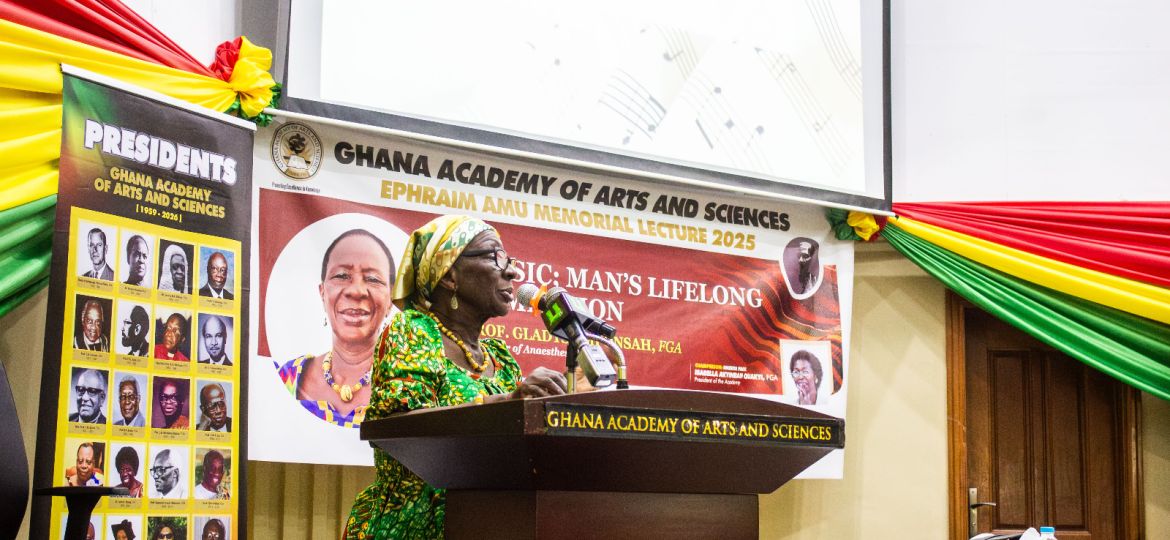
Professor Gladys Amponsah, FGA, a renowned Anaesthesiologist and respected member of the Ghana Academy of Arts and Sciences (GAAS), has urged Ghanaians to harness the power of music for its profound influence on child development, social life, therapy, and overall well-being.
She made this call on Thursday, 11th September 2025, while delivering the 2025 edition of the Ephraim Amu Memorial Lecture at the Academy’s auditorium in Accra. Speaking on the theme “Music: Man’s Lifelong Companion,” Prof. Amponsah wove together scientific research, cultural heritage, and lived experiences to show how music enriches humanity across every stage of life.
“Music has been shown to have a positive impact on diseases such as dementia, hypertension, and stroke, and can be a valuable tool for people with learning disabilities,” she explained. “It brings people together, improves health and resilience, and serves as a creative outlet that brings joy and enrichment to our lives.”
Her lecture traced the role of music from conception to old age, exploring its impact on work, health, academics, sports, and social cohesion. She illustrated how lullabies such as Tuu Tuu Gborvi aid child development, while Ghanaian rhythms like Agbadza, Borborbor, and Kpanlogo strengthen social bonds and preserve cultural identity. Drawing comparisons with global genres such as jazz and rock and roll, she underscored how music transcends borders while maintaining deep local roots.
Prof. Amponsah also highlighted music’s therapeutic potential. Beyond entertainment, she said, music plays a crucial role in healing the human spirit and addressing medical challenges. Studies continue to confirm its benefits in managing stress, supporting memory, improving cardiovascular health, and aiding rehabilitation for stroke survivors. “In medicine,” she noted, “we are learning to value music not as a distraction, but as an essential partner in treatment.”
While celebrating music’s strengths, she cautioned against its misuse, especially in contexts where lyrics or rhythms may promote harmful behaviours. However, she stressed that such risks should not overshadow the enduring value of music as a force for good. “Music is indeed a lifelong companion,” she concluded, “bringing joy, comfort, and meaning to the human journey.”
The lecture was interspersed with live performances, including renditions of both traditional and contemporary pieces, which deepened the audience’s appreciation for the subject. For many participants, the evening was not only informative but emotionally resonant, demonstrating that music is both knowledge and lived experience.
As Ghana’s premier learned society, GAAS continues to play a vital role in promoting scholarship and fostering dialogue on issues that matter to national and global life. The Academy’s memorial lectures, such as this one, honour the legacies of eminent Ghanaians while opening space for contemporary reflection. The Ephraim Amu Memorial Lecture, in particular, celebrates the memory of Dr. Ephraim Amu, the distinguished composer whose timeless works—including Yen Ara Asaase Ni, Yaanom Abibirimma, Asem Yi Di Ka, and Bonwire Kente (Kro Hi Kro)—remain cornerstones of Ghana’s cultural heritage.
By bringing together scholarship, music, and public engagement, this year’s lecture reaffirmed the Academy’s dual commitment to intellectual excellence and cultural preservation. It also showcased Prof. Amponsah’s versatility as both a scientist and a cultural advocate, reminding all present that the boundaries between science, art, and human well-being are far more connected than they may appear.

